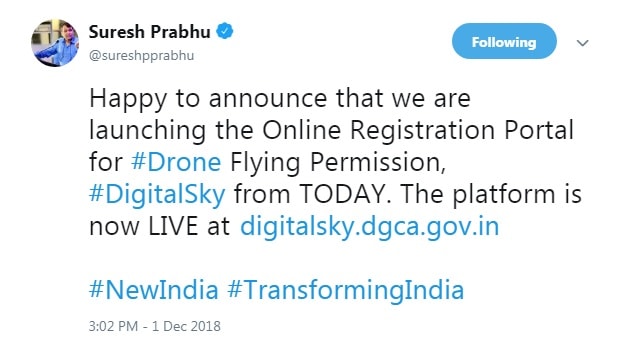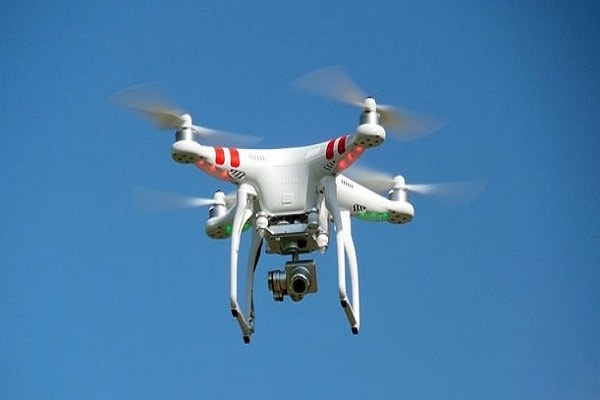Remotely Piloted Aerial Systems (RPAS), popularly referred to as drones, are a technology platform with wide-ranging applications. In August 2018, India had announced the release of its Civil Aviation Regulations (CAR) to enable safe flying of RPAS in India. The CAR detailed the obligations of operators, remote pilots/ users and manufacturers/ OEM for safe operations of RPAS and co-operative use of airspace. It also announced Digital Sky Platform, a first of its kind that implements 'No Permission, No Take-off’ (NPNT) – a novel system of software-based self-enforcement to minimize deviations from the CAR. The regulations were to come in effect from December 1, allowing the industry time to ready themselves for the launch. Nano drones in India can start flying legally. For micro and above categories, operators and pilots are required to register on the Digital Sky Portal (digitalsky.dgca.gov.in).

(Also read: Suresh Prabhu launches AirSewa 2.0)
The platform has begun accepting registrations of users. Payments for Unmanned Aerial Operator’s Permit (UAOP) and Unique Identification Numbers (UIN) will be accepted through the Bharat Kosh (bharatkosh.gov.in) portal.
To get permissions to fly, RPAS operators or remote pilots will have to file a flight plan. Flying in the ‘green zones’ will require only intimation of the time and location of the flights via the portal or the app. Permissions will be required for flying in ‘yellow zones’ and flights will not be allowed in the ‘red zones’. The location of these zones will be announced soon. Permission, if granted, will be available digitally on the portal.
(Also read: Commerce Minister Launches Logo and Brochure of Logix India)
If an RPAS does not have permission to fly, it will not be allowed to take-off under the policy of No Permission No-Takeoff (NPNT). This aspect of the portal is expected to be live soon. Existing drone operators are requested to contact their manufacturers for NPNT-compliant firmware upgrades & Equipment Type Approvals (ETA) from WPC Wing of DoT. Potential drone owners are required to buy NPNT-compliant RPAS. A point of contact in the Wireless Planning & Coordination (WPC) is available on the Digital Sky Website. Directorate General of Civil Aviation (DGCA) has released a list of Frequently Asked Questions as well as a list of Do’s & Don’ts for safe flying.
A detailed RPAS Guidance Manual has been released in November and is available on the DGCA website. This includes technical Specifications for NPNT compliance that will help manufacturers roll out relevant upgrades to their RPAS. The import of drones is now permitted as well, and a point of contact in the Directorate General of Foreign Trade (DGFT) is available on the Digital Sky Website.
(Also read: Election Commission of India announced the Launch of Its Newly Designed Website)
The Digital Sky Platform is built to evolve with the evolving needs of this rapidly changing industry. In the coming months, new features will be developed to ease the process of flying for users, and provide oversight to security agencies. Furthermore, it is envisioned that in the future Digital Sky Service Providers (DSPs) will be extending the functionality of the platform through Application Program Interfaces (APIs).
(Also read: PAiSA (Portal for Affordable credit and Interest Subvention Access), launched under DAY-NULM)
Minister of State for Civil Aviation, Shri Jayant Sinha said that, “Today, we have taken the first step towards our vision of seeing millions of drones fly in India. Drones are a frontier technology which has the potential to leapfrog India’s economic growth. This technology can greatly benefit our farmers, infrastructure entities like railways, roads, ports, mines and factories, sectors like insurance, photography, entertainment, etc.” The Minister for Civil Aviation has constituted a task-force on the recommendation of Drone Policy 2.0 under the chairmanship of the Minister of State. This task-force which is expected to release their final report by the end of this year. Drone 2.0 framework for RPAS are expected to include regulatory architecture for autonomous flying, delivery via drones and beyond visual line of sight (BVLOS) flights.
(Also read: Hausla 2018 of the Ministry of Women and Child Development inaugurated in New Delhi)
(Also read: Google to launch Neighbourly app across India, here are the 15 key features)
(Also read: Loan in 59 minutes, 12 key initiatives for the MSME sector by PM Modi)
Disclaimer: The above post includes some content used from PIB India website and executed on this website for fair use only. As this website is of educational nature, hence the content is used for education and awareness to the public.

